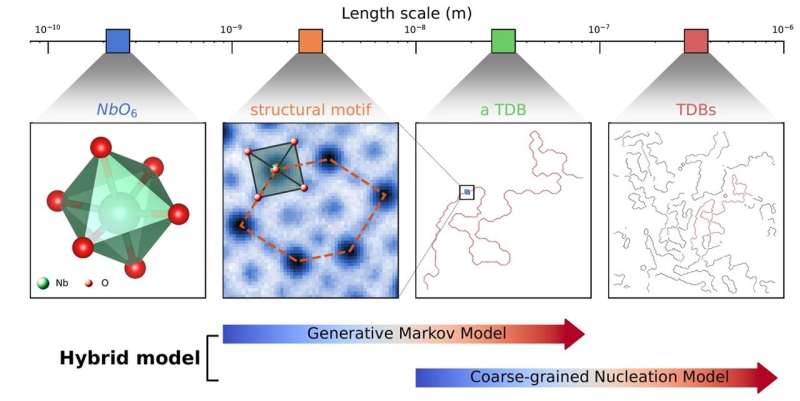This article has been reviewed according to Science X's editorial process and policies. Editors have highlighted the following attributes while ensuring the content's credibility:
fact-checked
peer-reviewed publication
trusted source
proofread
Generative model unveils secrets of material disorder

National University of Singapore (NUS) scientists have utilized generative machine learning models to explore the different methods in which atoms between adjacent crystals in a piezoelectric material, which are materials that generate a small electrical voltage upon application of mechanical stress, can experience mismatches. This revelation unveils the pathways through which disorder emerges in such materials.
In the realm of materials science, a longstanding question involves understanding if different structural disorders in complex materials serve valuable functions, with a key challenge being the identification of the types of disorder within a particular sample.
A research team at NUS addressed this challenge by condensing a wide range of structural disorder in domain boundaries of a piezoelectric material into a small set of simple, multiscale probabilistic rules. With these rules, they created a generative machine learning model that spanned three orders of magnitude in length scales, allowing the study of the material's statistical properties beyond practical measurement limits.
Led by Assistant Professor Ne-te Duane Loh from both the Department of Physics and the Department of Biological Sciences at NUS, the research team found that experimentally observed structural disorder along the domain boundaries of potassium-sodium niobate piezoelectric films could be distilled into a surprisingly compact set of simple probabilistic rules. These rules could be decomposed into two sets that dominate at distinct length scales—Markov chain and random nuclei. Using these two sets of rules creates the ensemble of domain boundaries for a specific material sample.
The team translated these probabilistic rules into the "vocabulary" and "grammar" of an interpretable machine learning model to generate and study a vast spectrum of realistic disordered domain boundaries that are indistinguishable from experimental measurements. This generative model provided access to orders of magnitude more observations than practical experimentation or expensive first-principles calculations would allow.
Using this model, the authors found previously undetected domain boundary motifs in the material, which are chain-like structures, shedding light on factors that could affect its piezoelectric response. They also found evidence that these domain boundaries maximize entropy. This breakthrough suggests that interpretable machine learning models can understand the complex nature of disorder in materials, paving the way towards understanding their function and design.
The research findings were published in the journal Science Advances.
This research continues the team's ongoing integration of statistical learning with atomic resolution electron microscopy to image complex materials. Dr. Jiadong Dan, the first author and the Eric and Wendy Schmidt AI in Science Fellow, said, "Our work can be generally extended and applied to other important systems where disorder plays an essential role in controlling the physical properties of materials."
The team also envisions further investigations into the functional importance of newly discovered structural motifs, highlighting the potential to understand and design complex materials.
Prof Loh added, "This work complements our earlier learning of atomic motif hierarchies. Together, they push us towards creating companion Artificial Intelligence (AI) alongside microscopes to provide unprecedented, fast feedback."
More information: Jiadong Dan et al, A multiscale generative model to understand disorder in domain boundaries, Science Advances (2023). DOI: 10.1126/sciadv.adj0904
Journal information: Science Advances
Provided by National University of Singapore





















